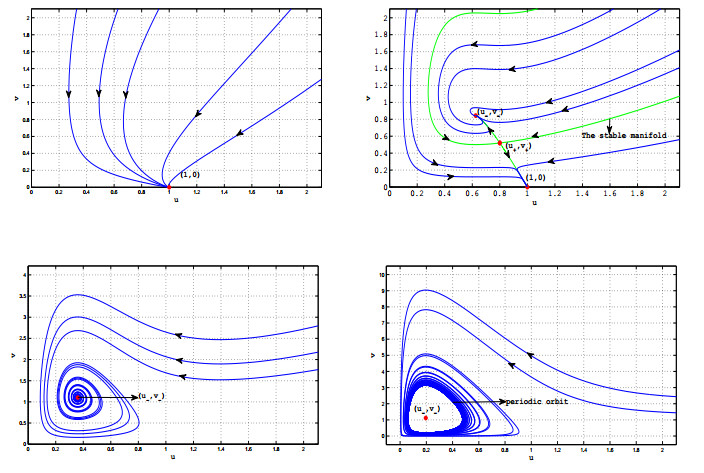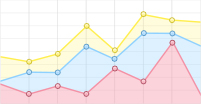|
[1]
|
C. Castillo-Chavez, Z. Feng, and W. Huang, Global dynamics of a plant-herbivore model with toxin-determined functional response, SIAM J. Appl. Math., 2012, 72(4), 1002-1020.
Google Scholar
|
|
[2]
|
J. Chattopadhayay, R. R. Sarkar, and A. El Abdllaoui, A delay differential equation model on harmful algal blooms in the presence of toxic substances, IMA J. Appl. Math., 2002, 19(2), 137-161.
Google Scholar
|
|
[3]
|
J. Chattopadhayay, R. R. Sarkar, and S. Mandal, Toxin-producing plankton may act as a biological control for planktonic blooms-Field study and mathematical modelling, J. Theor. Biol., 2002, 215(3), 333-344. doi: 10.1006/jtbi.2001.2510
CrossRef Google Scholar
|
|
[4]
|
J.-P Chen and H.-D Zhang, The qualitative analysis of two species predator-prey model with Holling type Ⅲ functional response, Appl. Math. Mech., 1986, 77(1), 77-86.
Google Scholar
|
|
[5]
|
K.-S. Cheng, Uniqueness of a limit cycle for a predator-prey system, SIAM J. Math. Anal., 1981, 12(4), 541-548.
Google Scholar
|
|
[6]
|
Z. Feng, R. Liu, and D. L. DeAngelis, Plant-herbivore interactions mediated by plant toxicity, Theor. Popul. Biol., 2008, 73(3), 449-459.
Google Scholar
|
|
[7]
|
G. M. Hallegraeff, A review of harmful algae blooms and the apparent global increase, Phycologia, 1993, 32, 79-99. doi: 10.2216/i0031-8884-32-2-79.1
CrossRef Google Scholar
|
|
[8]
|
S.-B. Hsu, On global stability of a predator-prey system, Math. Biosci., 1978, 39(1-2), 1-10.
Google Scholar
|
|
[9]
|
S.-B. Hsu, A survey of constructing lyapunov functions for mathematical models in population biology, Taiwanese J. Math., 2005, 9(2), 151-173. doi: 10.11650/twjm/1500407791
CrossRef Google Scholar
|
|
[10]
|
S.-B Hsu and T.-W Huang, Global stability for a class of predator-prey systems, SIAM J. Appl. Math., 1995, 55(3), 763-863.
Google Scholar
|
|
[11]
|
M. Javidi and N. Nyamoradi, Dynamic analysis of a fractional order phytoplankton model, J. Appl. Anal. Comput., 2013, 3(4), 343-355.
Google Scholar
|
|
[12]
|
S. Khare, O. P. Misra, and J. Dhar, Role of toxin producing phytoplankton on a plankton ecosystem, Nonlinear Anal. Hybri., 2010, 4(3), 496-502. doi: 10.1016/j.nahs.2009.11.006
CrossRef Google Scholar
|
|
[13]
|
W. Ko and K. Ryu, Qualitative analysis of a predator-prey model with Holling type Ⅱ functional response incorporating a prey refuge, J. Differential Equations, 2006, 231(2), 534-550. doi: 10.1016/j.jde.2006.08.001
CrossRef Google Scholar
|
|
[14]
|
R. Liu, Z. Feng, H. Zhu, and D. L. DeAngelis, Bifurcation analysis of a plant-herbivore model with toxin-determined functional response, J. Differential Equations, 2008, 245(2), 442-467. doi: 10.1016/j.jde.2007.10.034
CrossRef Google Scholar
|
|
[15]
|
Y. Lv, J. Cao, J. Song, R. Yuan, and Y. Pei, Global stability and Hopf-bifurcation in a zooplankton-phytoplankton model, Nonlinear Dyn., 2014, 76, 345-366. doi: 10.1007/s11071-013-1130-2
CrossRef Google Scholar
|
|
[16]
|
B. Mukhopadhyay and R. Bhattacharyya, A delay-diffusion model of marine plankton ecosystem exhibiting cyclic nature of blooms, J. Biol. Phys., 2005, 31, 3-22. doi: 10.1007/s10867-005-2306-x
CrossRef Google Scholar
|
|
[17]
|
P. Y. H. Pang and M. Wang, Non-constant positive steady states of a predator-prey system with non-monotonic functional response and diffusion, Proc. London Math. Soc., 2004, 88(3), 135-157.
Google Scholar
|
|
[18]
|
R. Peng and J. Shi, Non-existence of non-constant positive steady states of two Holling type-Ⅱ predator-prey systems: Strong interaction case, J. Differential Equations, 2009, 247(3), 866-886.
Google Scholar
|
|
[19]
|
M. Rehim and M. Imran, Dynamical analysis of a delay model of phytoplankton-zooplankton interaction, Appl. Math. Model., 2012, 36(2), 638-647.
Google Scholar
|
|
[20]
|
S. Ruan and D. Xiao, Global analysis in a predator-prey system with nonmonotonic functional response, SIAM J. Appl. Math., 2001, 61(4), 1445-1472.
Google Scholar
|
|
[21]
|
T. Saha and M. Bandyopadhyay, Dynamical analysis of toxin producing phytoplankton-zooplankton interaction, Nonlinear Anal. Real World Appl., 2009, 10, 314-332. doi: 10.1016/j.nonrwa.2007.09.001
CrossRef Google Scholar
|
|
[22]
|
J. Wang, Spatiotemporal patterns of a homogeneous diffusive predator-prey system with Holling type Ⅲ functional response, J. Dyn. Diff. Equat., 2017, 29(4), 1383-1409. doi: 10.1007/s10884-016-9517-7
CrossRef Google Scholar
|
|
[23]
|
Y. Wang, H. Wang, and W. Jiang, Hopf-transcritical bifurcation in toxic phytoplankton-zooplankton model with delay, J. Math. Anal. Appl., 2014, 415(2), 574-594. doi: 10.1016/j.jmaa.2014.01.081
CrossRef Google Scholar
|
|
[24]
|
Y. Wang, and W. Jiang, Bifurcations in a delayed differential-algebraic plankton economic system, J. Appl. Anal. Comput., 2017, 7(4), 1431-1447.
Google Scholar
|
|
[25]
|
G. S. K. Wolkowicz, Bifurcation analysis of a predator-prey system involving group defence, SIAM. J. Appl. Math., 1988, 48(3), 592-606.
Google Scholar
|
|
[26]
|
D. Xiao and H. Zhu, Multiple focus and Hopf bifurcations in a predator-prey system with nonmonotonic functional response, SIAM J. Appl. Math., 2006, 66(3), 802-819.
Google Scholar
|
|
[27]
|
F. Yi, J. Wei, and J. Shi, Bifurcation and spatiotemporal patterns in a homogeneous diffusive predator-prey system, J. Differential Equations, 2009, 246(5), 1944-1977. doi: 10.1016/j.jde.2008.10.024
CrossRef Google Scholar
|
|
[28]
|
C.-H. Zhang and X.-P. Yan, Formation of time patterns in a diffusive plant-herbivore system with toxin-determined functional response, Int. J. Biomath., 2015, 8(4), 1550051.
Google Scholar
|
|
[29]
|
H. Zhao, X. Huang, and X. Zhang, Hopf bifurcation and harvesting control of a bioeconomic plankton model with delay and diffusion terms, Physica A, 2015, 421, 300-315. doi: 10.1016/j.physa.2014.11.042
CrossRef Google Scholar
|
|
[30]
|
J. Zhao, J. P. Tian, and J. Wei, Minimal model of plankton systems revisited with spatial diffusion and maturation delay, Bull. Math. Biol., 2016, 78(3), 381-412. doi: 10.1007/s11538-016-0147-3
CrossRef Google Scholar
|
|
[31]
|
J. Zhao and J. Wei, Dynamics in a diffusive plankton system with delay and toxic substances effect, Nonlinear Anal.: Real World Appl., 2015, 22, 66-83. doi: 10.1016/j.nonrwa.2014.07.010
CrossRef Google Scholar
|
|
[32]
|
Y. Zhao, Z. Feng, Y. Zheng, and X. Cen, Existence of limit cycles and homoclinic bifurcation in a plant-herbivore model with toxin-determined functional response, J. Differential Equations, 2015, 258(8), 2847-2872. doi: 10.1016/j.jde.2014.12.029
CrossRef Google Scholar
|
|
[33]
|
J. Zhou and C. Mu, Coexistence states of a Holling type-Ⅱ predator-prey system, J. Math. Anal. Appl., 2010, 369(2), 555-563. doi: 10.1016/j.jmaa.2010.04.001
CrossRef Google Scholar
|
|
[34]
|
H. Zhu, S. A. Campbell, and G. S. K. Wolkowicz, Bifurcation analysis of a predator-prey system with nonmonotonic function response, SIAM J. Appl. Math., 2002, 63(2), 636-682.
Google Scholar
|






 DownLoad:
DownLoad: